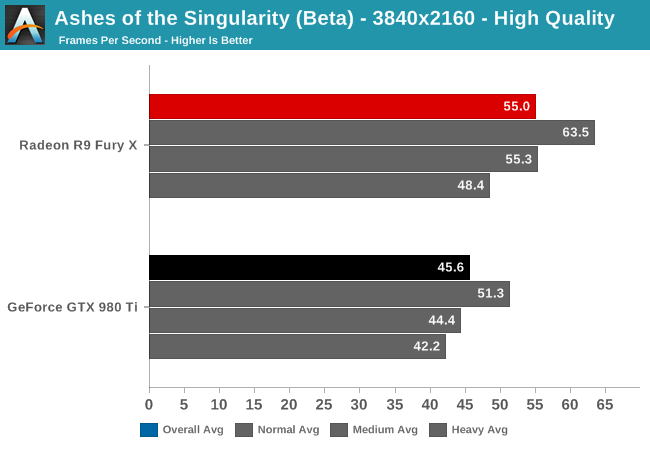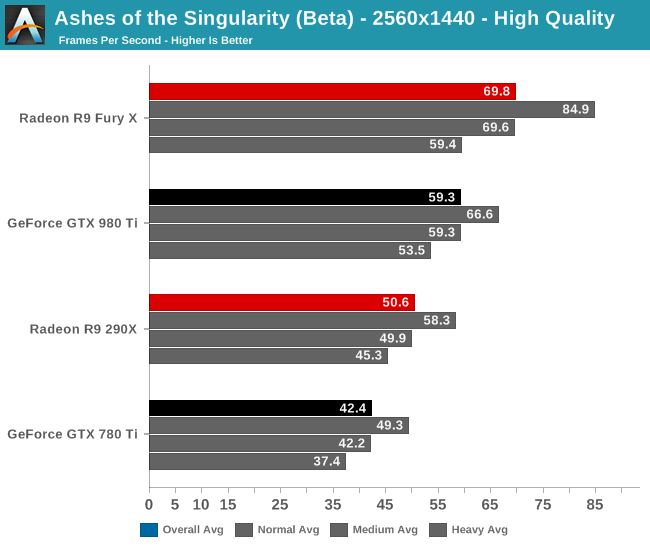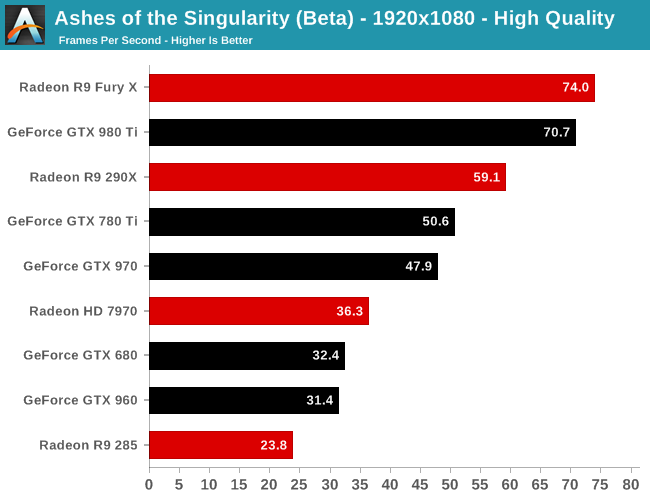Ashes of the Singularity Revisited: A Beta Look at DirectX 12 & Asynchronous Shading
by Daniel Williams & Ryan Smith on February 24, 2016 1:00 PM ESTDirectX 12 Single-GPU Performance
We’ll start things off with a look at single-GPU performance. For this, we’ve grabbed a collection of RTG and NVIDIA GPUs covering the entire DX12 generation, from GCN 1.0 and Kepler to GCN 1.2 and Maxwell. This will give us a good idea of how the game performs both across a wide span of GPU performance levels, and how (if at all) the various GPU generational changes play a role.
Meanwhile unless otherwise noted, we’re using Ashes’ High quality setting, which turns up a number of graphical features and also utilizes 2x MSAA. It’s also worth mentioning that while Ashes does allow async shading to be turned off and on, this option is on by default unless turned off in the game’s INI file.

Starting at 4K, we have the GeForce GTX 980 Ti and Radeon R9 Fury X. On the latest beta the Fury X has a strong lead over the normally faster GTX 980 Ti, beating it by 20% and coming close to hitting 60fps.

When we drop down to 1440p and introduce last-generation’s flagship video cards, the GeForce GTX 780 Ti and Radeon R9 290X, the story is much the same. The Fury X continues to hold a 10fps lead over the GTX 980 Ti, giving it an 18% lead. Similarly, the R9 290X has an 8fps lead over the 780 Ti, translating into a 19% performance lead. This is a significant turnabout from where we normally see these cards, as 780 Ti traditionally holds a lead over the 290X.
Meanwhile looking at the average framerates with different batch count intensities, there admittedly isn’t much remarkable here. All cards take roughly the same performance hit with increasingly larger batch counts.

Finally at 1080p, with our full lineup of cards we can see that RTG’s lead in this latest beta is nearly absolute. The 2012 flagship battle between the 7970 and the GTX 680 puts the 7970 in the lead by 12%, or just shy of 4fps. Elsewhere the GTX 980 Ti does close on the Fury X, but RTG’s current-gen flagship remains in the lead.
The one outlier here is the Radeon R9 285, which is the only 2GB RTG card in our collection. At this point we suspect it’s VRAM limited, but it would require further investigation.










153 Comments
View All Comments
tuxRoller - Friday, February 26, 2016 - link
It's the simpler drivers which provide less room to hide architectural deficiencies.My point was that, across the board, gcn improves its performance a good deal relative to d3d11. That includes cards that are four years old. I don't think Maxwell is older than that.
I don't think we are really disagreeing, though.
RMSe17 - Wednesday, February 24, 2016 - link
Nowhere near as bad as the DX9 fiasco back in the FX 5xxx days where a low level ATi card would demolish the highest end GeForcept2501 - Thursday, February 25, 2016 - link
Few if anyone here is going to remember the fiasco when the radeon 9700 pro demolished the competition in performance and stability. Even fewer remember nvidia "optimizing" games with lower quality textures to compete.dray67 - Thursday, February 25, 2016 - link
I remember it and it was the reason I went for the 9700 and the later 9800, atm I'm back to Nvidia I've had 2 AMD card die on me due to heat, as much as I like them I've had my fingers burnt and moved away from them, if dx12 and dual gpu support becomes better supported I'll buy a high AMD card in an instant.knightspawn1138 - Thursday, February 25, 2016 - link
I remember it clearly. My Radeon 9800 was the last ATI card I bought. I loved it for years, and only ended up replacing it with an NVidia card when the Catalyst Control Center started sucking all the cycles out of my CPU. It's funny that half of the comments on this article complain that NVidia's drivers are over-optimized for every specific game, yet ATI and AMD were content to allow the CCC to be a resource hog that ruined even non-gaming performance for years. I'm happy with my NVidia cards. I've been able to easily play all modern games with great performance using a pair of GTX 460's, and recently replaced those with a GTX 970.xenol - Thursday, February 25, 2016 - link
Considering there aren't any other async shader games in development and nothing announced and with Pascal coming within the next year (which maybe, a game might actually use DX12) which will probably alleviate the situation, your evaluation of NVIDIA's situation is pretty poor.It takes more than a generation or a game to make a hardware company go down. NVIDIA suffered plenty during its GeForce FX days, and it got right back on its feet.
MattKa - Thursday, February 25, 2016 - link
No, no, no. An RTS game that probably isn't going to sell very well and seems incredibly lacking is going to destroy Nvidia.gamerk2 - Thursday, February 25, 2016 - link
AMD has had an async compute engine in their GPUs going back to the 7000 series. NVIDIA has not. Stands to reason AMD would do better in async compute based benchmarking.Let's see how Pascal compares, since it's being designed with DX12, and async compute, in mind.
agentbb007 - Saturday, February 27, 2016 - link
"NVIDIA telling us that async shading is not currently enabled in their drivers", yeah this pretty much sums it up. This beta stuff is interesting but just that beta...JlHADJOE - Saturday, February 27, 2016 - link
The GTX 680 seems to have done well though. I feel like Maxwell is being let down by the compromises Nvidia made optimizing for FP16 only and sacrificing real compute performance.